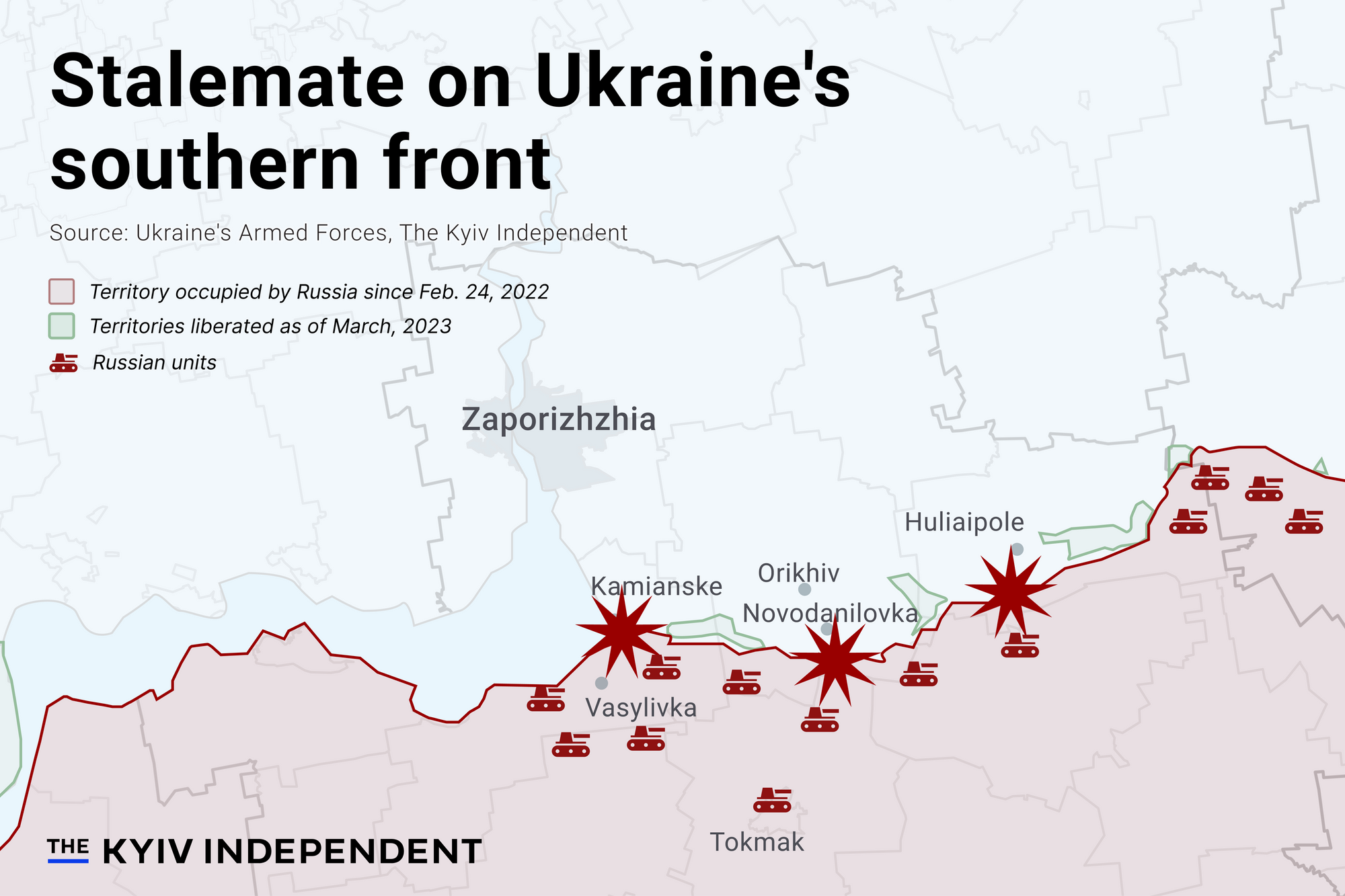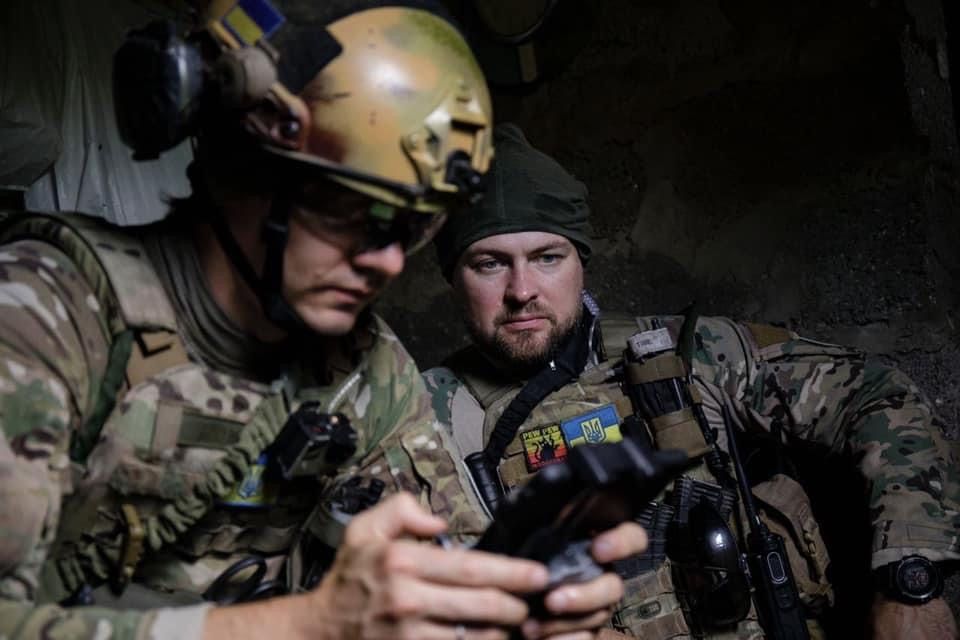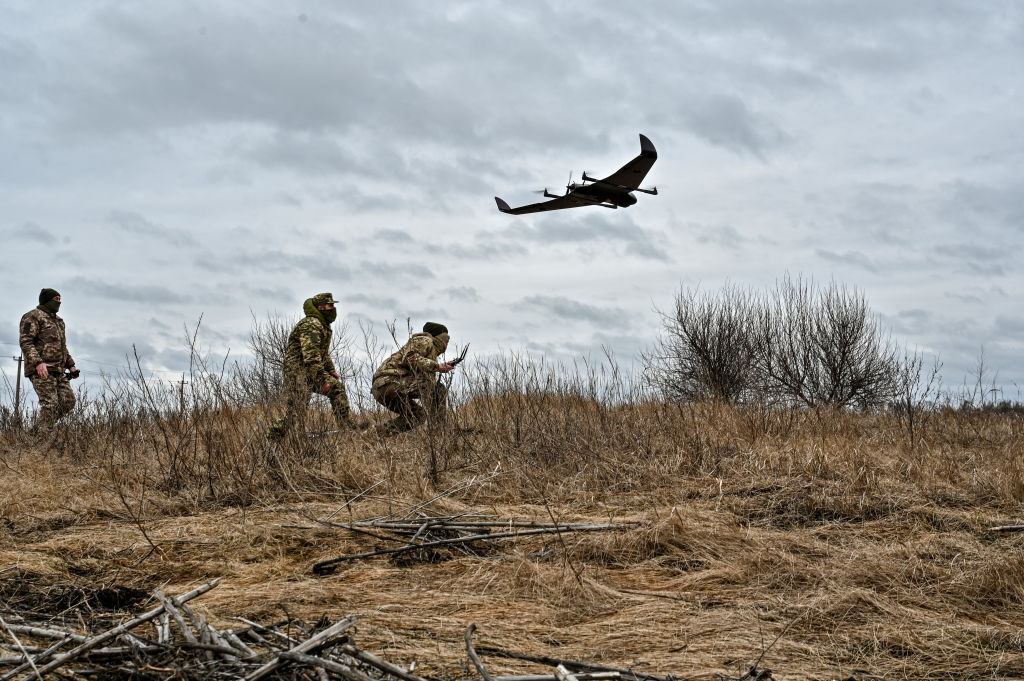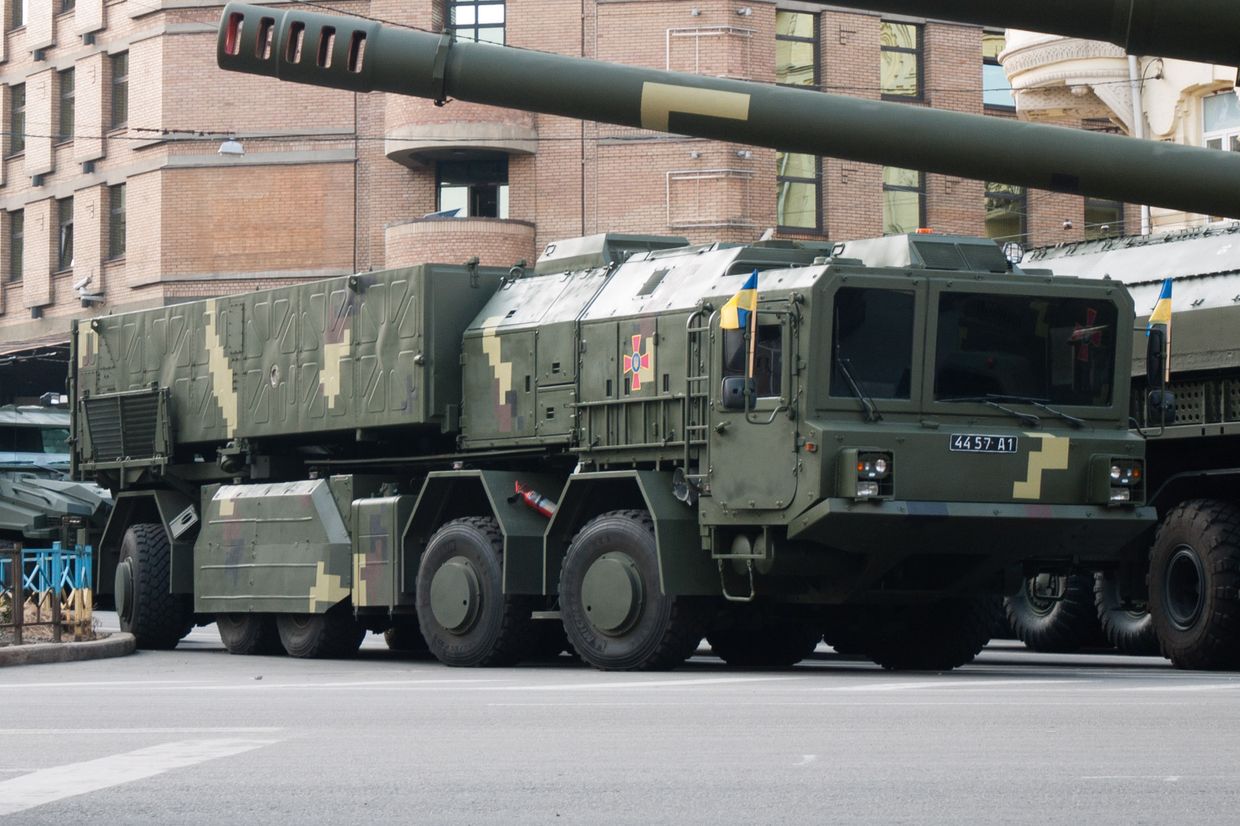Zaporizhzhia Oblast – In a split-second, two Ukrainian jets appear over the road, releasing chaff that sets off a couple of Russian anti-aircraft missiles.
It allows one of the planes to hit a Russian position that billows with black smoke rising over the trees, leaving no doubt on how close the two sides are to one another.
Such skirmishes are frequent in the Zaporizhzhia Oblast, where most battles are fought with artillery duels, air sorties, and localized clashes over a few villages nearby.
Close to the southern front line of Russian-controlled territories, a quick drive down the bumpy roads of the oblast reveals trenches with soldiers, shovels in hand, plowing through the fields on long lines along the way.
Preparations to fortify the area look well underway, but the spring counteroffensive promised by the Ukrainian government in the south still seems to be in the distant future for the soldiers stationed there, harassed by Russians' constant shelling.

The situation on the front line remains challenging for Ukraine in the south, but Russian troops can’t advance, Southern Operational Command spokesperson Natalia Humeniuk said on March 14. The U.K. Defense Ministry attributed it to Russia’s aggravating artillery ammunition deficit.
A Ukrainian officer in his fifties, who declined to give his name for safety reasons because he leads a mobile anti-aircraft unit in the region, told the Kyiv Independent that the front was "moderately stable" despite a few Russian attempts to break through Ukraine's defensive lines.
"They're looking for our weak spots," he says, "but we haven't let them take even a meter."

Stable front line
The front line hasn't moved much since May last year despite a few localized engagements, police officer Valentyn Ilchuk, call sign Burzhui, told the Kyiv Independent.
"Kamianske was attacked a couple of weeks ago, Orikhiv is being attacked all the time, and for Huliaipole, we lost positions and retook them," he says.
The shelling never stops on the front line, slowly reducing cities nearby into uninhabitable, dangerous piles of rubble and forcing residents who stayed to live all day long in shelters.
However, there is no sign of a significant offensive so far, from one side or the other, the officer assesses.
There was a lot more fighting between February and May last year, taking and retaking positions, and then the front stabilized, he says.
According to the U.S.-based Institute for the Study of War, Russian forces are unable to conduct large-scale, simultaneous offensive campaigns on multiple axes.
Vadym Skibitsky, deputy head of Ukrainian military intelligence, said on March 23 that Ukrainian forces fixed Russians to multiple areas on the front line, and that the Russian troops in occupied Crimea and Kherson and Zaporizhzhia oblasts were preparing to defend, not attack.
Russian forces occupied 60% of Zaporizhzhia Oblast as of June last year, according to local authorities, and the situation hasn't evolved since.
Lieutenant General Serhii Naiev, one of the senior commanders of the Ukrainian Armed Forces, said on March 20 that due to Russia focusing its offensive effort on Luhansk and Donetsk oblasts, “there are not enough forces and means to conduct offensive actions in other directions.”
“The Russians are trying to create the impression that they are preparing offensive actions in other operational areas, primarily in Zaporizhzhia, in order to divert the attention of our military command,” Naiev told RBC Ukraine news outlet.
Russian artillery ammunition deficit, likely aggravating over the recent weeks, has led to "extremely" tight ammunition restrictions in many areas of Ukraine's front line, including the south, the U.K. Defense Ministry concluded on March 14.
"This has almost certainly been a key reason why no Russian formation has recently been able to generate operationally significant offensive action," the ministry said.
On the ground, soldiers confirm that the southern front line is relatively stable.
"It's a bit frozen, our men are manning their positions, Russians take care of theirs," Ilchuk says.
Ilchuk is a corporal who serves in the Thor Group, formerly a police special operation unit, now working in collaboration with Ukraine’s intelligence, tasked with scouting and reconnaissance missions in the region.
He admits that he expected more action when he arrived in the area after the Kherson counteroffensive.
"It feels like this general direction is a bit abandoned by both parties," he says.

Ilchuk believes Ukraine threw significant resources to the Donbas, where fierce battles have been ongoing around Bakhmut to deplete Russian forces ahead of a potential counteroffensive in the southeast.
Ilchuk believes that neither Ukrainians nor Russians have concentrated enough manpower or firepower in the southern direction to advance, compared to the Kherson offensive that began in August, in which he took part.
Kherson was the only regional capital Russia had managed to capture since the launch of the full-scale war in February.
Russians troops were forced to completely withdraw from the city amid Kyiv's advancing months-long counteroffensive during the summer of 2022, culminating with the town's liberation on November 11, 2022.
"It's getting more intense these days, but it's much less intense than Kherson was. I'd never seen that much heavy gear in my life," he said of the Kherson operation.
With up to a hundred tanks and a couple of hundreds of armored vehicles, "it looked like f***ing Mad Max," he says. He says he hasn’t seen a similar level of concentration of equipment where he is now.
Ilchuk thinks the stalemate may continue as Russians lack the resources to advance further.
Troop concentration
Compared to eastern hotspots such as Bakhmut or Vuhledar, on the southern front line, the Russian forces are far less concentrated, and the regiments are spread out, according to open-source military maps such as DeepState.
Still, the concentration of troops keeps increasing, according to Ashot, call sign "Doc," a drone unit commander garrisoned in the region.
Ukraine's intelligence claimed on Feb. 6 that Russia was prepared to mobilize 300,000 to 500,000 troops to sustain a significant offensive in the Donbas and "possibly" in the southeastern Zaporizhzhia Oblast in spring and summer.
From above, Ashot’s drones recently witnessed a growing concentration of Russian troops, but he didn't specify how many. And yet, he said they brought less and less equipment with them compared to the beginning of the invasion.
"The Russian army received a lot of new soldiers, but they come without tanks or armored vehicles, even without new artillery," he says.
And it's the same all along the southern front line, from the village of Malynivka to nearby Orikhiv.
Ashot believes such a concentration of troops is part of Russia's strategy to try and exhaust Ukraine's Armed Forces while sparing their equipment.
"They try to keep their equipment for the next offensive," he says.
And Russians are learning from their initial mistakes, according to the mobile air defense officer.
"They learned from Ukrainian tactics," the air defense officer says. "First, (they send) a small group of people, and then, their machines join the fight."
Ukrainian forces advance roughly one kilometer in some villages, such as Novodanilovka and Mala Tokmachka, along the front line, but Russians are trying to take them back relentlessly.
"We kill and wound them, but they keep coming," the officer says, asking for more modern, Western weapons to take better shots at Russians.

Only five of the 24 men who shared his quarters during the opening months of 2022 are still alive.
"It's tragic how many young men died because of wasted time over Western weapons," the officer says. "They give us enough weapons not to surrender, but it's not enough," he adds.
Waiting to strike
Meanwhile, Ukrainian soldiers are looking forward to a potential counteroffensive that many believe might still happen in the south despite fights in the east.
Ukraine's upcoming spring counteroffensive will aim to "drive a wedge into the Russian front in the south between Crimea and mainland Russia," Skibitsky said in an interview with German media back in February.
Skibitsky said he thinks Ukraine will be ready for its counteroffensive in the spring but said the exact moment it begins would depend on a number of factors, including the supply of Western weapons.
"Right now, the situation is difficult, but we're holding the line and even advancing a bit, even if it's for one kilometer or two," says a soldier, call sign "Taxist," who declined to provide his name because his family remains under Russian occupation.

The soldier believes it would be tough to take back Melitopol, occupied since late February 2022, and turned into a fortress with a series of concrete-built echelon defense lines.
Melitopol, located roughly 100 kilometers from the current southern front line, has regularly been depicted as the next big target for Ukrainian Armed Forces in the south.
Taking Melitopol, located between Kherson and Mariupol, would allow Ukraine to cut Russian supply lines from Crimea to Donbas and push further toward Berdiansk and the Azov Sea.
However, the soldier says Russian forces had almost a year to dig in.
Satellite images taken in January show that Russians built anti-tank ditches and trenches for their soldiers, establishing at least three lines of defense before reaching Tokmak, roughly 25 kilometers from the current front line and north of Melitopol.
"It's gonna be a tough fight," Taxist said. "But we have enough artillery for the moment and good morale."
Note from the author:
Hello, this is Alexander Query, back from the southern front line, to give you an accurate glimpse of the current situation. My colleagues and I are trying to be your eyes and ears on the ground, so you can understand what’s happening in Ukraine because the war continues far from the headlines. We’ll continue to deliver on this mission, but we need your help and support to keep us going. If you enjoyed this reading, please consider supporting us.














